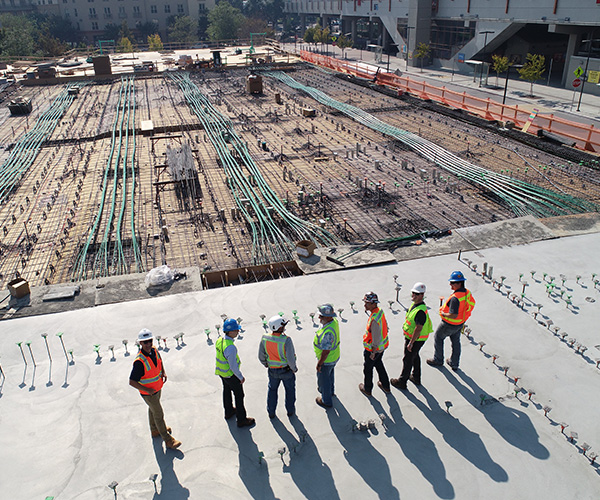Safety Training in Construction Staffing: Ensuring Ongoing Compliance and Awareness
WEBUILD STAFFING BLOG |
Safety Training in Construction Staffing: Ensuring Ongoing Compliance and Awareness

Safety training has always been a critical aspect of construction staffing, given the inherently hazardous nature of the industry. Over the years, safety regulations, practices, and technologies have evolved significantly to address emerging risks and enhance workplace safety. Let’s explore the evolution of safety training in construction staffing, from traditional methods to innovative approaches, and highlight the importance of ongoing compliance and awareness in creating safer work environments for construction workers.
The Importance of Safety Training in Construction Staffing:
Construction sites are dynamic environments with numerous hazards, including falls, electrical hazards, struck-by incidents, and caught-in/between accidents. According to the Occupational Safety and Health Administration (OSHA), the construction industry accounts for a significant portion of workplace fatalities and injuries each year. Safety training plays a crucial role in mitigating these risks by equipping construction workers with the knowledge, skills, and awareness needed to identify hazards, prevent accidents, and respond effectively to emergencies.
Evolution of Safety Training Methods:
- Traditional Classroom Training:
Historically, safety training in construction staffing relied heavily on traditional classroom-based instruction, where workers would attend lectures, presentations, and demonstrations on safety topics such as fall protection, hazard communication, and personal protective equipment (PPE). While classroom training remains a valuable component of safety education, it has limitations in terms of accessibility, engagement, and effectiveness, particularly for remote or dispersed workforces.
- Hands-On Training and Demonstrations:
Hands-on training and demonstrations involve practical exercises, simulations, and drills designed to simulate real-world scenarios and reinforce safety principles. This experiential approach allows construction workers to apply safety concepts in a controlled environment, practice using safety equipment, and develop muscle memory and reflexes for safe work practices. Hands-on training can be particularly effective for teaching skills such as proper ladder usage, scaffold erection, and equipment operation.
- Interactive E-Learning Platforms:
With the advent of technology, e-learning platforms have emerged as a popular and effective alternative for safety training in construction staffing. Interactive e-learning courses incorporate multimedia elements such as videos, animations, quizzes, and virtual simulations to engage learners and enhance retention of key concepts. E-learning platforms offer the flexibility to deliver training anytime, anywhere, and at the learner’s own pace, making it accessible to a wider audience and reducing the logistical challenges associated with traditional classroom training.
- Mobile Learning Apps and Gamification:
Mobile learning apps and gamification techniques have revolutionized safety training by making it more interactive, engaging, and enjoyable for construction workers. Mobile apps allow workers to access safety training modules, resources, and job aids on their smartphones or tablets, enabling just-in-time learning on the job site. Gamification elements such as points, badges, and leaderboards incentivize participation, encourage competition, and motivate workers to complete training modules and achieve mastery of safety concepts.
- Virtual Reality (VR) and Augmented Reality (AR) Simulations:
Virtual reality (VR) and augmented reality (AR) simulations offer immersive, lifelike experiences that simulate hazardous scenarios and environments in a safe and controlled manner. VR and AR technology allow construction workers to practice safety procedures, identify hazards, and respond to emergencies in a realistic virtual environment, without exposing them to actual risks. VR and AR simulations enhance engagement, retention, and transfer of learning by providing hands-on, experiential training experiences that closely resemble real-world conditions.
Importance of Ongoing Compliance and Awareness:
While advancements in safety training methods have enhanced the effectiveness and accessibility of training programs, ongoing compliance and awareness are essential for ensuring that safety standards are upheld and enforced consistently across construction sites. Compliance with OSHA regulations, industry standards, and best practices requires a multifaceted approach that includes:
- Regular Training Updates and Refresher Courses:
Safety regulations and best practices are constantly evolving in response to emerging risks, technological advancements, and changing industry trends. Construction staffing agencies must stay abreast of these developments and update their training programs accordingly to ensure that workers receive the most up-to-date information and instruction on safety procedures, protocols, and regulations.
- Continuous Monitoring and Evaluation:
Construction staffing agencies should implement systems and processes for monitoring and evaluating the effectiveness of safety training programs and interventions. This includes tracking key performance indicators (KPIs) such as training completion rates, incident rates, near-misses, and safety culture surveys to assess the impact of training on workplace safety and identify areas for improvement.
- Employee Engagement and Participation:
Employee engagement and participation are critical for the success of safety training initiatives. Construction workers should be actively involved in the development, implementation, and evaluation of safety training programs to ensure that their needs, perspectives, and experiences are taken into account. Encourage workers to provide feedback, share insights, and participate in safety committees or working groups to promote a culture of ownership and accountability for safety.
- Leadership Commitment and Support:
Leadership commitment and support are essential for fostering a culture of safety within construction staffing agencies and client organizations. Senior leaders should lead by example, prioritize safety as a core value, and allocate resources and support for safety training initiatives. By demonstrating a visible and active commitment to safety, leaders can inspire trust, confidence, and buy-in from employees at all levels of the organization.
- Collaboration and Knowledge Sharing:
Construction staffing agencies should collaborate with industry partners, trade associations, regulatory agencies, and other stakeholders to share best practices, lessons learned, and emerging trends in safety training and compliance. By participating in industry forums, conferences, and working groups, construction staffing agencies can stay informed about the latest developments in safety management and contribute to collective efforts to improve safety standards and practices across the construction industry.
The evolution of safety training in construction staffing reflects a commitment to continuous improvement, innovation, and excellence in workplace safety. By embracing new technologies, fostering a culture of safety, and prioritizing employee engagement and participation, construction staffing agencies can uphold the highest standards of safety and well-being for their workers and contribute to a safer and more sustainable future for the construction industry as a whole.
Webuild Staffing Agency is a leading executive search and staffing agency dedicated to the construction, engineering and environmental industries. To learn more please visit: www.webuildstaffing.com










